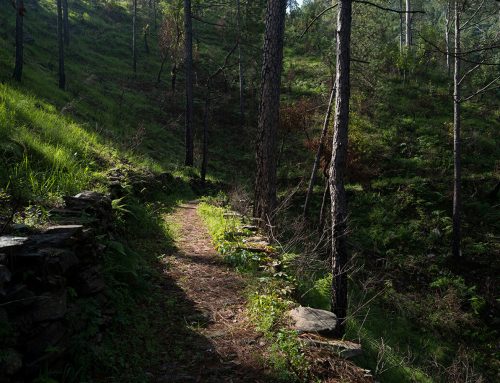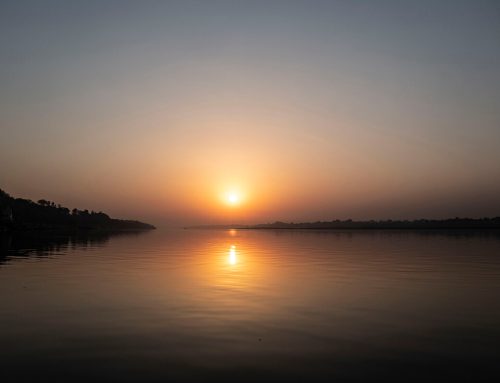A visit to the inner sanctum of Arunachaleswar Temple for darshan
The past few years, I’ve traveled to Mysore to study Ashtanga Yoga, but with the passing of the guru, Sri K Pattabhis Jois, on May 18, 2009, I decide to have a different kind of spiritual experience in India. I want to find a place, rather than a person, to be my teacher. My experience in the past with Native American culture and expeditions into wilderness taught me that the earth could be a spiritual teacher. I fly to Chennai and, after decompressing in the seashore temple town of Mahabalipuram, travel through a South Indian landscape of green rice paddies and coconut groves to the Holy Mountain. The cars slowly diminish and the road becomes populated with rural life – shepherds herd their goats, oxen pull heavily-loaded wooden carriages, women artfully balance anything on their heads from colourful plastic water jugs to 8 foot-long palm debris to be used for firewood. Sacred cows, homeless dogs and uniformed school children all jostle for space with bicycles, rickshaws, taxis and the odd lorry. I enter a world of people and animals working together in nature. Images of locals bringing their livestock back from fields at dusk look like a romantic cliché of a bygone era. Time stands still.








I phoned several hotels only to discover that Tiruvannamalai is, indeed, a thriving, pilgrimage centre with few rooms available, none near the Ramana Maharishi ashram. I take a room at the Trishul Hotel, a modern Indian lodge in hot, dusty, noisy downtown centre. Not wanting to waste a moment, I walk through mud lanes, the temple bazaars and throngs of beggars to arrive at Arunachaleswar Temple. The entrance is an impressive gopuram (monumental tower), ornately carved in true Dravidian style that marks the point where we must leave behind all that is time-bound and limited in order to seek that which is eternal and infinite. I feel stuck by how palpable spirituality is in India – the constant reminder to rise above the existential worries of everyday existence. A guard, brings me back to mundane reality and reminds me to remove my shoes, as is customary when entering holy places. I contemplate whether to pay a few rupees to someone to watch my shoes, or keep them really safe and stuff them in my bag. My feet get filthy crossing the street to the temple and I wonder about the meaning of this custom.



Inside this portal to the divine, I’m awestruck by the sheer enormity of the temple complex connected by extensive corridors and inner/outer prakarams, or rampart walls, pierced on four sides with colossal towers rising 66 m high. The era of its founding is unknown; the complex grew over several millennia. The gopurams were erected between the 10th and 16th centuries. It was later refurbished during the Vijayanagara era (14th -17th C). I pass by several mysterious linga shrines and glimpse at a pantheon of deities associated with Shiva, all puja-ed up and decorated with red bindis on their foreheads, covered in flowers and adorned in exquisite silk. On the outer edges, there are others that seem forlorn, sadly forgotten dressed in tattered cloth as if there are too many to dress each day. Strange anthropomorphic stones are dressed up as Gods against a background of swastikas – the ancient Hindu symbol of peace. They’re not exactly beautiful, more occultist or fetishistic, from some secret Tamil past. I vow to return in daylight to see the intricate carvings, especially the one of Lord Siva dancing in an elephant’s skin. But there is a dark energy here that might be from visiting at night, or that the stone is dark grey, or the mysterious shrines with ancient deities.

I arrive at the inner sanctum and pay 20 INR for ‘Special Darsan’ and am led to the front of the long queue by a priest. Darsan is the act of seeing and being seen by the Gods. It can be the beholding of an auspicious deity, person, or object. The experience is thought to be reciprocal and results in the blessing of the viewer and protects Hindus against demons and evil realities of mortal life. At the altar, Puja is made. Incense is burned, spirits evoked, flowers laid on a phallic Siva lingham, or ‘wand of light’. I’m blessed and receive Siva’s trademark horizontal line of white ash. I try to get out of the way of my own ignorance surrounding these ceremonies, and remain open to receive any blessings, or energy, that is meant for me, and trust that I will absorb what is intended.
In another hall, a group of devotees await another ‘special’ darsan, this time from the temple elephant. Children shyly hold out rupees that are adeptly accepted with its trunk and promptly given to its trainer (who I later found out was quite cruel), something it has done every day for the past 40 years. Children cower and squeal with delight as the trunk gently lands on their head. Everything is symbol of all that is human aspiring to be Divine, and all that is divine incarnating in the manifest world of shape and form. The temple has a spiritual weight perhaps accumulated from the prayers of millions of pilgrims dating back thousands of years. It’s the most functional and well-used temple I’ve been in and I see why it made of materials that last the stretches of time. There is something quite comforting about walking barefoot on the smooth granite floors, warm from the heat of the sun, treading the same path as millions of others, getting lost in the larger humanity.
On the way out, I visit the Pathala Linga shrine beneath the Thousand-Pillared Hall, where Sri Ramana Maharshi stayed when he first arrived in Tiruvannamalai. Absorbed in Samadhi, he didn’t notice the insects stinging him and vermin eating his body. Eventually, a local saint, Seshadri Swamigal, discovered him in the vault and had him removed and taken to the mountain where he remained to the end of his mortal life.








